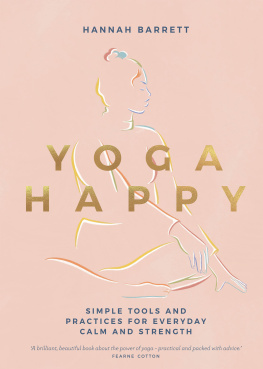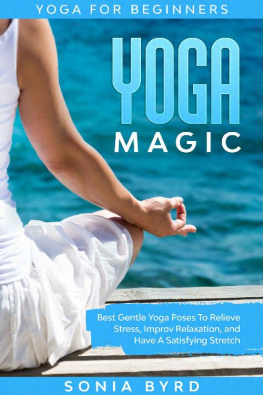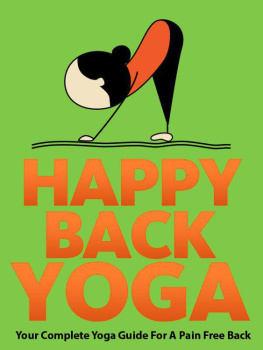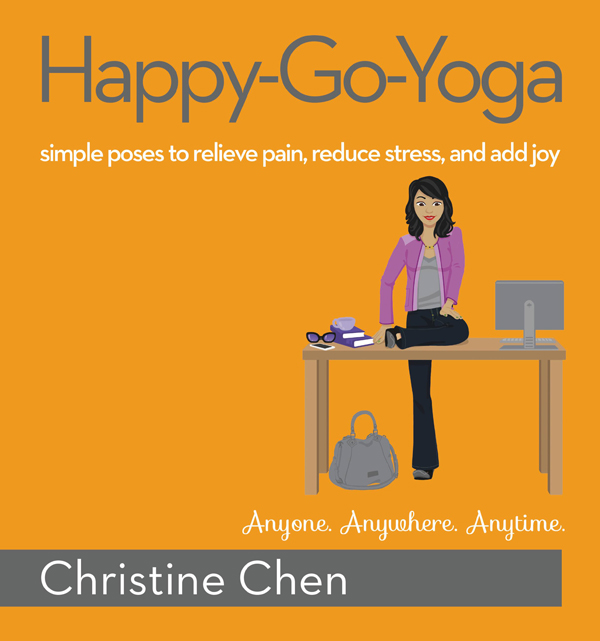In accordance with the U.S. Copyright Act of 1976, the scanning, uploading, and electronic sharing of any part of this book without the permission of the publisher constitute unlawful piracy and theft of the authors intellectual property. If you would like to use material from the book (other than for review purposes), prior written permission must be obtained by contacting the publisher at permissions@hbgusa.com. Thank you for your support of the authors rights.
Paul J. Christo, MD
Host of Aches and Gains and Associate Professor,
Division of Pain Medicine, Johns Hopkins University School of Medicine
When Christine decided to embark on writing a book on yoga that would encourage body movement for good health, stress reduction, and pain relief, I was excited. Our modern lifestyle has significantly reduced natural movement and replaced it with inaction. We sit in front of computers for hours each day. We sit in cars, trains, buses, or airplanes en route to meetings, our job, or even leisure activities. At night, we sit in plush chairs or lie on comfortable couches to watch our favorite reality TV shows.
Unfortunately, all of this sedentary time has led to unfavorable health outcomes. More of us are obese, have heart disease, suffer from diabetes, and constantly strain the joints of our spines and limbs. Were designed to move, yet were mostly immobile. The benefits of exercise are numerous, but most important, its the fundamental step toward feeling better.
Evidence of the growing value of complementary and alternative medicine (CAM) and therapies like yoga for reaching optimal health and healing is steadily increasing. A 2007 National Health Interview Survey reported that more than 38 percent of American adults and almost 12 percent of children used some type of CAM therapy during the previous year. In fact, pain is among the most common reasons for seeking CAM treatments and specifically for easing lower-back pain.
Its easy to understand why more of my own pain patients are feeling the positive effects of CAM treatments, and especially yoga. As a form of exercise and moving meditation, yoga offers them pain relief, improves their mood and body mass index, and helps them reduce risk factors associated with chronic diseases. Patients tell me that the deep stretching combined with relaxation and the deep and rhythmic breathing of yoga promotes well-being and comfort. It makes them feel better, more alive, and more able to withstand the stresses of daily life.
Today, were learning more about the effects on the body of slow and deep breathing. Interestingly, some studies tell us that slow breathing reduces pain, and some experts feel that slow, deep breathing suppresses the sympathetic nervous system (fight or flight response), which in turn influences how pain is processed in the nervous system.
If you look at the evidence for yogas effects on pain, youll see that the practice allows patients to better cope with the biological, psychological, and social dimensions of having persistent pain. This is critical because pain can take over your life and make you feel like youre a prisoner. Yoga offers a way out through gentle exercise and a refreshing relaxation. Ive seen benefits in patients with arthritis in easing tender and swollen joints. And Ive seen yoga help patients with fibromyalgia lessen their pain and fatigue and elevate their mood and ability to cope. And Ive heard from patients that they feel less stressed, more resilient, and less injury-prone.
Yoga is low risk, low cost, and well tolerated. This is a perfect trio for my own patients who may be afraid of worsening their pain or who may have limited finances. Yoga can be practiced in class or even at home. Even simple exercises can be taught in the doctors office for those too injured or otherwise unable to take classes. Researchers are currently studying the effects of yoga on older adults specifically because of its global benefit to health and balance.
I mentioned initially that I was excited, and now you can understand the reason. Happy-Go-Yoga helps you take that first step toward mobilizing your body and mind. As an experienced yoga instructor, Christine Chen has written a smart, fun, and easy guide for healthy living. Yoga offers you the potential to improve your life, feel better, and regain a sense of wellness.
As a pain specialist whos seen many patients freed from their discomfort, Im enthusiastic about the promise of CAM treatments, and especially yoga. I hope that in reading Christines book, youre able to awaken a new potential to take care of yourself, overcome any medical limitations, and achieve what you want in life.
I went to my first yoga class in 1999 to tackle stress and back pain. At the time I was a news anchor and reporter, and I was unable to sit at the news desk or stand for a live report without experiencing shooting and/or throbbing pain. My high-octane life of constant deadlines, odd hours, lack of sleep, and weird working conditions manifested in two different spine conditions and high anxietybad news for a newsperson. Sometimes I would lie on the floor during commercial breaks just so I could feel enough relief to get up and muster a smile for the cameras despite the pain.
Every minute at work was filled with talk of disaster, crisis, controversy, and violence, all of which had taken a toll on my heart and my personal life. I had few coping skills for this level and type of stress, so, like many others in the industry, I became jaded, turned to cocktails, and held it all ina recipe for toxicity. Three of my friends/coworkers with similar lifestyles were diagnosed with cancer in their mid-thirties, and one passed away a few years ago. Gratefully, I never got so sick that I was on life support, but certainly, I was not supporting my own health very well.
Because of my spine, my doctors banned me from nearly all the activities that helped me cope with stress, including the super-sweaty cardio workouts that also kept me slim and camera-ready. Doctors even instructed me to get in and out of a car a special way. Most nights I couldnt sleep without medication. Every part of my life was compromised by my health, and my health was being compromised by every part of my lifea terrible cycle that kept eroding my mind, body, and spirit. I felt like I was in a physical and emotional storm cloud every day. A single gal at the time, I was not a fun date. My soul was suffering, and I feared I would never find my soul mate. In a word, I was unhappy.
In the midst of an array of medical treatments for my spine problems, including anti-inflammatory spine injections, electro-stimulus, prescription drugs, acupuncture, and months of physical therapy, I tried yoga. I felt better physically, at first, just for short periods of time. I was skeptical about whether yoga would help me. Lets be honest; before, I had been stress busting by kickboxing, and this was the total opposite. But I found I was challenged physically by the poses and measurably calmer after each class. I was curious to know more. Doctors said that to fix my spine they would have to cut through the front of my neck for surgery. Even so, they could not guarantee total pain relief. Faced with that reality, I kept going to yoga.
I wavered between skeptic and willing student. I fit in as many classes as my schedule allowed and was fortunate to have knowledgeable and caring teachers. When I couldnt make it to class, I did pieces of the poses from class, and I did them everywhere. I stretched at the news desk during commercial breaks. I twisted in the corners of airports. I breathed deeply in traffic jams to relax. I meditated to cope with one chaotic situation after another. I cant recall exactly when things shifted, but yoga became part of my everyday life.







